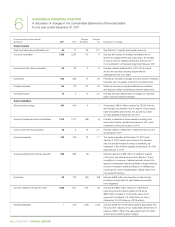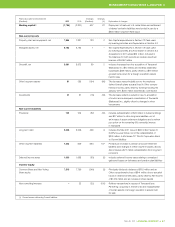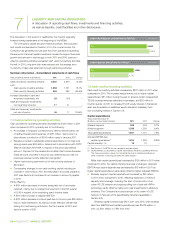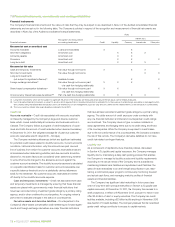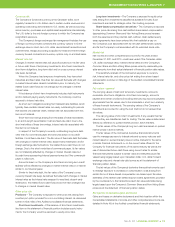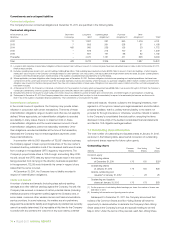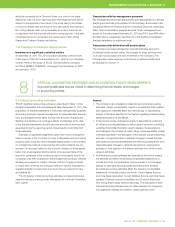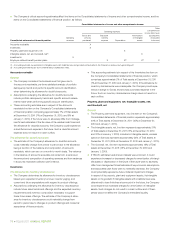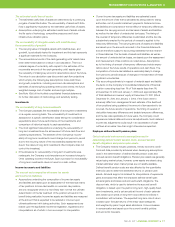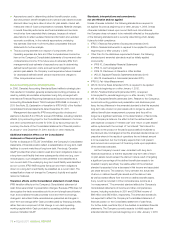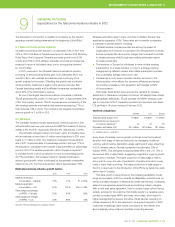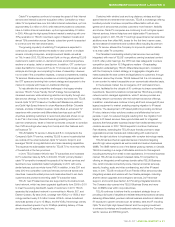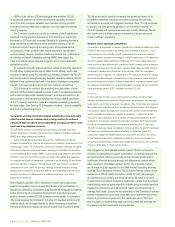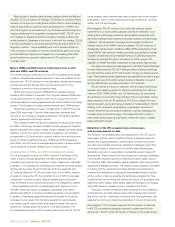Telus 2011 Annual Report Download - page 80
Download and view the complete annual report
Please find page 80 of the 2011 Telus annual report below. You can navigate through the pages in the report by either clicking on the pages listed below, or by using the keyword search tool below to find specific information within the annual report.
76 . TELUS 2011 ANNUAL REPORT
.The Company’s critical accounting estimates affect line items on the Consolidated statements of income and other comprehensive income, and line
items on the Consolidated statements of financial position, as follows:
Consolidated statements of income and other comprehensive income
Other
comprehensive
Operating expenses
income (Item never
Goods and Employee Amortization subsequently
Operating services benefits of intangible reclassified
Consolidated statements of financial position revenues purchased expense Depreciation assets to income)
Accounts receivable X
Inventories X
Property, plant and equipment, net X
Intangible assets, net, and Goodwill, net(1) X
Investments X
Employee defined benefit pension plans X X(2) X
(2) X
(1) Accounting estimate, as applicable to intangible assets with indefinite lives and goodwill, primarily affects the Company’s wireless cash-generating unit.
(2) Accounting estimate impact due to internal labour capitalization rates.
Accounts receivable
General
.The Company considers the business area that gave rise to
the accounts receivable, performs statistical analysis of portfolio
delinquency trends and performs specific account identification
when determining its allow ance for doubtful accounts.
.Assumptions underlying the allowance for doubtful accounts
include portfolio delinquency trends and specific account assess-
ments made when performing specific account identification.
.These accounting estimates are in respect of the Accounts
receivable line item on the Company’s Consolidated statements
of financial position comprising approximately 7% of Total assets
at December 31, 2011 (7% at December 31, 2010, and 6% at
January 1, 2010). If the future were to adversely differ from manage-
ment’s best estimates of the fair value of the residual cash flows and
the allowance for doubtful accounts, the Company could experience
a doubtful account expense in the future. Such a doubtful account
expense does not result in a cash outflow.
The allowance for doubtful accounts
.The estimate of the Company’s allowance for doubtful accounts
could materially change from period to period due to the allowance
being a function of the balance and composition of accounts
receivable, which can vary on a month-to-month basis. The variance
in the balance of accounts receivable can arise from a variance in
the amount and composition of operating revenues and from variances
in accounts receivable collection performance.
Inventories
The allowance for inventory obsolescence
.The Company determines its allowance for inventory obsolescence
based upon expected inventory turnover, inventory aging, and
current and future expectations with respect to product offerings.
.Assumptions underlying the allowance for inventory obsolescence
include future sales trends and offerings and the expected inventory
requirements and inventory composition necessary to support
these future sales offerings. The estimate of the Company’s allow-
ance for inventory obsolescence could materially change from
period to period due to changes in product offerings and consumer
acceptance of those products.
.This accounting estimate is in respect of the Inventories line item on
the Company’s Consolidated statements of financial position, which
comprises approximately 2% of Total assets at December 31, 2011
(1% at December 31, 2010 and January 1, 2010). If the allowance for
inventory obsolescence were inadequate, the Company could expe-
rience a charge to Goods and services purchased expense in the
future. Such an inventory obsolescence charge does not result in a
cash outflow.
Property, plant and equipment, net; Intangible assets, net;
and Goodwill, net
General
.The Property, plant and equipment, net, line item on the Company’s
Consolidated statements of financial position represents approximately
40% of Total assets at December 31, 2011 (40% at December 31,
2010 and January 1, 2010).
.The Intangible assets, net, line item represents approximately 31%
of Total assets at December 31, 2011 (31% at December 31, 2010
and 32% at January 1, 2010). Included in Intangible assets, wireless
spectrum licences represent approximately 24% of Total assets at
December 31, 2011 (25% at December 31, 2010 and January 1, 2010).
.The Goodwill, net, line item represents approximately 18% of Total
assets at December 31, 2011 (18% at December 31, 2010 and
January 1, 2010).
.If TELUS’ estimated useful lives of assets were incorrect, it could
experience increased or decreased charges for amortization of intangi-
ble assets or depreciation in the future. If the future were to adversely
differ from management’s best estimate of key economic assumptions
and associated cash flows were to materially decrease, the Company
could potentially experience future material impairment charges
in respect of its property, plant and equipment assets, its intangible
assets or its goodwill. If intangible assets with indefinite lives were
determined to have finite lives at some point in the future, the Company
could experience increased charges for amortization of intangible
assets. Such charges do not result in a cash outflow and of them-
selves would not affect the Company’s immediate liquidity.


